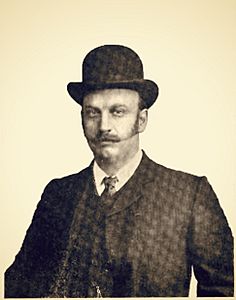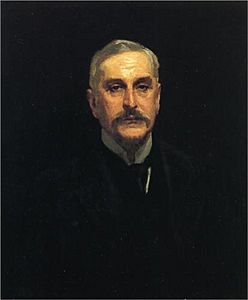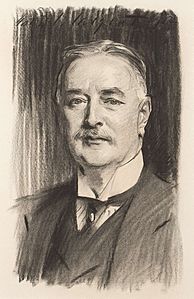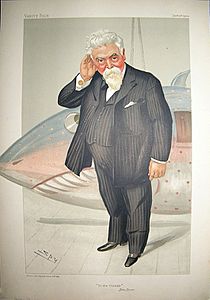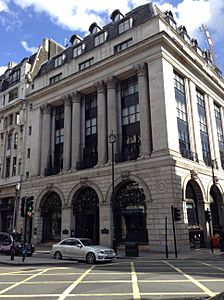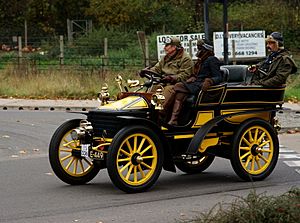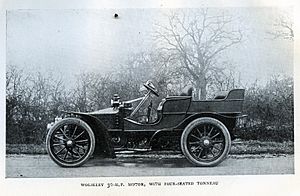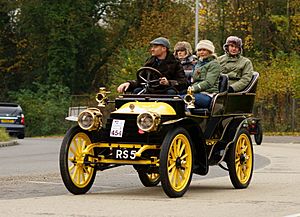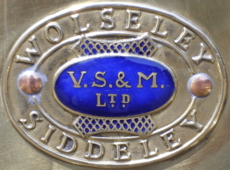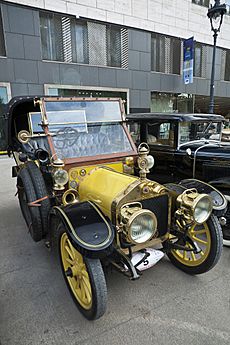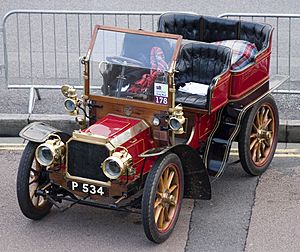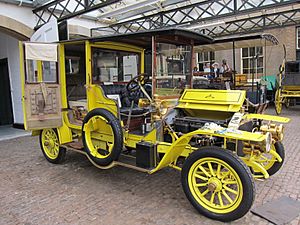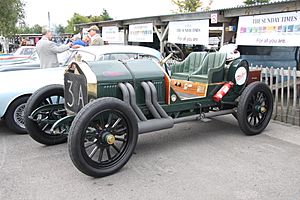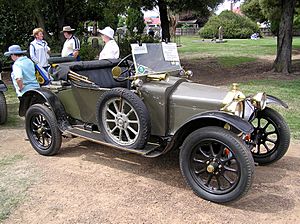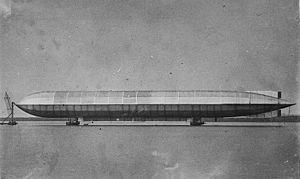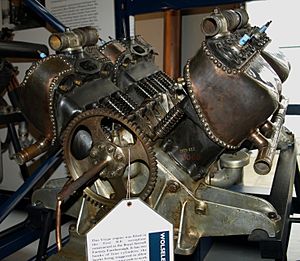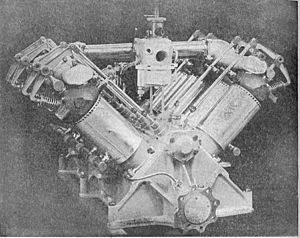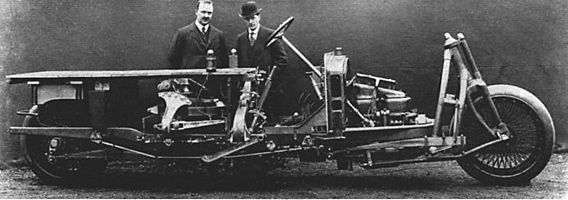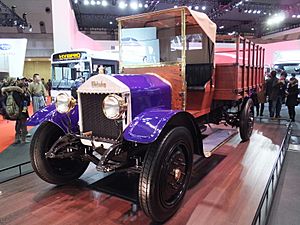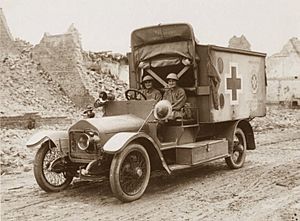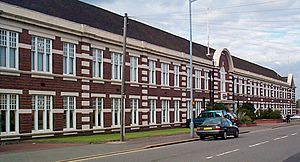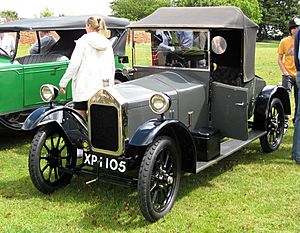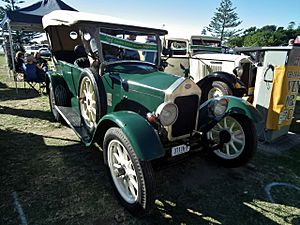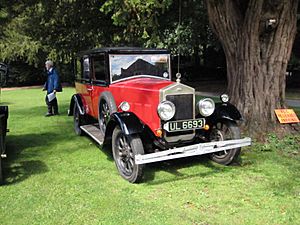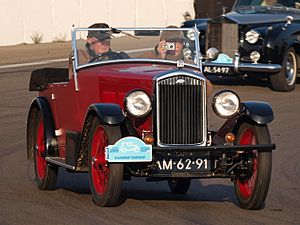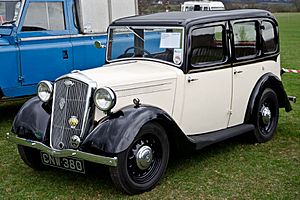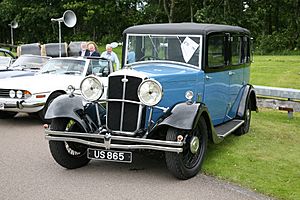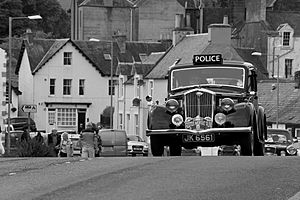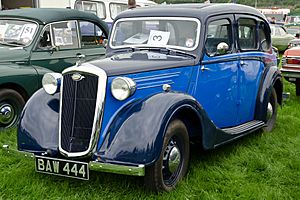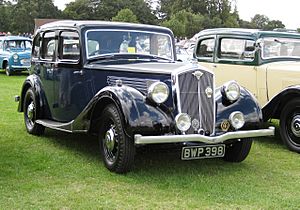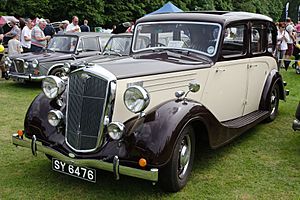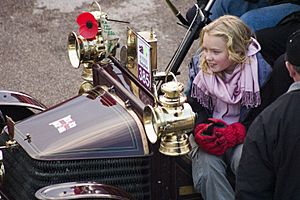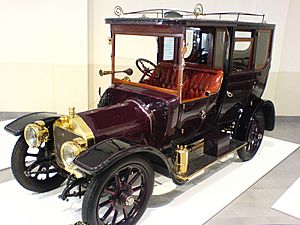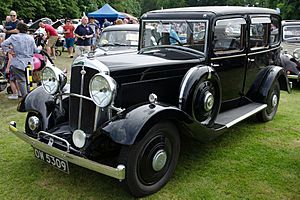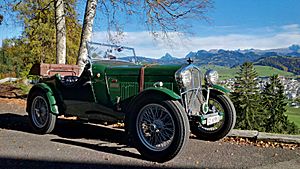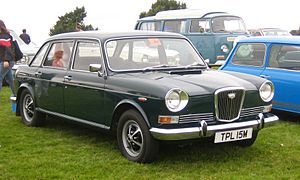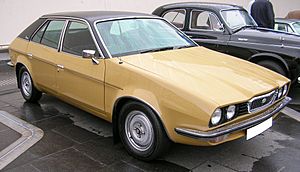Wolseley Motors facts for kids
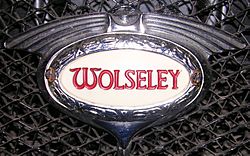 |
|
| Industry | Automotive |
|---|---|
| Fate | Merged |
| Successor | British Motor Corporation |
| Founded | 1901 |
| Defunct | 1975 |
| Headquarters | Birmingham, England |
|
Key people
|
Thomas and Albert Vickers Herbert Austin J D Siddeley A J McCormack W R Morris |
Wolseley Motors Limited was a British car maker. It was started in 1901 by the Vickers company and Herbert Austin. At first, Wolseley made many types of cars, including big luxury ones. They were very popular in the early 1900s.
After World War I, Wolseley grew very fast. In 1921, they made 12,000 cars. This made them the biggest car manufacturer in Britain. But growing too fast caused problems. In 1927, the company went bankrupt.
William Morris, who later founded Morris Motors, bought Wolseley. He added it to his car empire before World War II. After the war, Wolseley cars were mostly Morris cars with a different badge. The Wolseley name stopped being used in 1975.
| Product type | Automotive marque |
|---|---|
| Owner | SAIC Motor |
| Discontinued | 1975 |
| Previous owners | Vickers, Sons and Maxim (1901–1927) W R Morris (1927–1935) Morris Motors Limited (1935–1952) BMC (1952–1967) British Leyland (1967–1986) Rover Group (1986–1988) BAe (1988–1994) BMW (1994–2000) MG Rover (2000–2005) NAC (2005–2007) |
Starting the Company in 1901
-
Sir Hiram Maxim
(1840–1916)
The Wolseley Tool and Motor Car Company
Hiram Maxim, who invented the famous machine gun, worked with Herbert Austin. Austin was working for The Wolseley Sheep Shearing Machine Company Limited. They talked about designs for flying machines.
The sheep shearing company decided not to make cars. So, Vickers, Sons and Maxim, a big armaments company, stepped in. They bought Austin's car ideas.
In March 1901, The Wolseley Tool and Motor Car Company was formed. It was based in Birmingham and made cars and tools. Herbert Austin was the managing director. After five years, Austin left to start his own company, The Austin Motor Company Limited.
Austin's Early Wolseley Cars
Herbert Austin was looking for new products for the sheep-shearing company. He became interested in engines and cars around 1895. He built his first car based on a design he saw in Paris.
In 1897, Austin showed his second Wolseley car. It had three wheels and seating for two people. It wasn't very successful. His third car, a four-wheeled "Voiturette," came out in 1899.
The first Wolseley cars sold to the public were based on the "Voiturette." Production started in 1901. By 1906, Wolseley had made over 1,500 cars. It was the biggest British car maker, and Austin became famous.
In May 1901, Austin released his first car catalog. There were two models: 5 horsepower and 10 horsepower. They could have different bodies and tires. The 10 hp model could even have a special brake to stop it from rolling backward.
Wolseley cars from 1901 to 1905 had flat engines. This design kept the car's center of gravity low. The engines had one, two, or four cylinders.
In 1904, Queen Alexandra bought a large 24 hp Wolseley car. It had a powerful 5.2-liter engine.
John Siddeley Takes Over
John Siddeley started his own car company in 1902. By 1905, Wolseley bought his business. Siddeley became the London sales manager for Wolseley.
A few months later, Herbert Austin left Wolseley. He wanted to use new upright engines, but the company directors disagreed. Siddeley took over as manager. He quickly changed Wolseley cars to use the new upright engines.
This change made Wolseley cars seem more modern. Sales stayed strong under Siddeley. However, the company had too many different locations. They closed the Crayford factory and moved everything to Birmingham. They also stopped making commercial vehicles and taxis.
Siddeley resigned from Wolseley in 1909. He then joined another car company.
Wolseley in Italy: Wolsit
In 1907, a company called Wolsit Officine Legnanesi Autmobili started in Italy. They built Wolseley cars under a special agreement. Wolsit stopped making cars in 1909. After that, they made luxury bicycles.
The Wolseley car range in 1909 included many models. After 1911, the cars were simply called "Wolseley" again.
Wolseley's business grew quickly. The factory in Adderley Park was made much bigger in 1912. A new, cheaper car model called Stellite was made by another Vickers company.
Other Products: Tools, Buses, and More
Wolseley didn't just make cars. They were also general engineers for other Vickers companies. They built double-decker buses for Birmingham. They also made electric lights and engines for motor boats. These boat engines ranged from 12 hp to 250 hp.
They also made fire engines and special vehicles for the army. As a company with "tool" in its name, they built machine tools. They also made large engines for petrol-electric trains. In 1905, they offered small railway locomotives.
The amazing Brennan mono-rail truck used a 20 hp Wolseley engine. This engine powered the special system that kept the truck balanced. It also used an 80 hp Wolseley engine for movement.
Engines for Boats and Airplanes
Wolseley first made engines for small boats. Then they started making engines for larger ships and racing boats. They also made special engines for lifeboats. In 1906, they designed 16-cylinder engines for British submarines.
They also made advanced V8 engines for hydroplanes. These engines were very light and powerful. The airship Mayfly used Wolseley engines.
By 1910, Wolseley was making special water-cooled airplane engines. These included 30 hp and 60 hp V8 engines. A 120 hp version soon followed.
Wolseley also designed special tractors with tracks. These were supplied to Robert Falcon Scott for his trip to the Antarctic.
In 1914, Wolseley made a unique two-wheeled car for an inventor. It looked like a huge motorcycle with a car body. It could balance itself when stopped using a special gyroscope. This car was put aside when World War I started.
Commercial Vehicles
From 1912, Wolseley started making lorries and other commercial vehicles. Before World War I, they offered six types of commercial vehicles. These ranged from small delivery vans to large five-ton lorries.
Wolseley Motors Limited in 1914
By 1913, Wolseley was Britain's biggest car maker, selling 3,000 cars. The company changed its name to Wolseley Motors Limited in 1914. They also started operations in Canada. The chairman said the factory space was over 17 acres.
Wolseley During World War I
When World War I began, Wolseley was Britain's largest car maker. They first made cars for officers and ambulances. But soon, the government asked them to make more important war supplies.
After the war, Wolseley reported what they had made. This included:
- 3,600 cars and lorries
- 4,900 airplane engines
- 760 airplanes
- Many airplane parts like wings and propellers
- Parts for battleships, cruisers, and destroyers
- 1,200 naval gun mounts
- Parts for airships
- Millions of shells and bombs
They produced many types of aero engines during the war. One was the "Viper," a V8 engine. By 1918, they made sixty of these engines every week.
A special operating car was designed using a Wolseley chassis. It had an operating table and surgical tools. This car was used in various campaigns during the war.
In 1918, Wolseley started a joint company in Tokyo, Japan. The first Japanese-built Wolseley car was made in 1922. After World War II, this company became Isuzu Motors in 1949.
Growth and Problems After the War
After the war, Wolseley's factories had grown a lot. The Vickers directors decided to make many cars at lower prices. They borrowed money to expand even more.
Wolseley bought the Ward End factory from Vickers in 1919. They also bought a place for a new showroom in London. They spent a lot of money on this new building.
But then, government contracts ended. A special tax was put on wartime profits. There was also a workers' strike. Then, in 1920, many car orders were cancelled. Wolseley lost money. In 1922, other car makers lowered their prices. By 1924, Wolseley was losing a lot of money.
In 1926, it was announced that the company was bankrupt. This was a big failure in the early car industry.
Wolseley Under Morris
William Morris Takes Over
In February 1927, William Morris bought Wolseley for £730,000. He used his own money. He might have bought it to stop General Motors from getting it.
Other companies like Austin Motor Company also wanted to buy Wolseley. Herbert Austin, who started Wolseley, was sad he couldn't buy it back. Morris already had a connection to Wolseley. His Morris Garages in Oxford sold Wolseley cars.
Morris wanted to make a good six-cylinder car. Wolseley's 16–45 model, a 2-liter six-cylinder car, impressed him.
Morris created a new company called Wolseley Motors (1927) Limited. He moved all production to the Ward End Works in Birmingham. He sold parts of Wolseley's old factory. He also moved his Morris Commercial Cars business there.
Vickers had tried to make Wolseley build cheap cars in large numbers. Morris changed this plan. He wanted Wolseley to keep its reputation for luxury. He kept the 2-liter six-cylinder 16–45 car. He also introduced a four-cylinder version called the 12–32. An eight-cylinder car, the 21–60, was also launched.
Wolseley's engines after the war had a special overhead-camshaft design. This design was used in the Morris Minor and later in the Wolseley Hornet. It was also used in some famous MG car models.
Wolseley Joins Morris Motors
In 1935, Morris transferred his ownership of Wolseley to Morris Motors Limited. After this, Wolseley cars became very similar to Morris cars. They were "badge-engineered," meaning they were the same car with a different badge.
Wolseley joined Morris, MG, and later Riley in the Morris Organisation. This group was later called the Nuffield Organization.
After World War II
After World War II, Wolseley production moved to Cowley. The first Wolseley cars after the war were the 4/50 and 6/80. They used Wolseley engines but were based on Morris cars. They had the classic Wolseley grille.
The Wolseley 6/80 was a top model. It had great style and features. Its engine was more powerful than the Morris version. These cars were used by the British police for many years.
Wolseley and BMC
In 1952, Austin and Morris merged to create the British Motor Corporation (BMC). Wolseley cars then shared bodies and chassis with MG and Riley cars. Examples include the 4/44 and 6/90.
In 1957, the Wolseley 1500 was launched. It shared its body with the Riley One-Point-Five. The next year, the Wolseley 15/60 came out. It was a new mid-sized BMC car designed by Pinin Farina.
The Wolseley Hornet was based on the Mini. It had a special trunk and was also sold as the Elf. The Wolseley 1100 came out in 1965, and the Wolseley 1300 in 1967. Finally, a version of the Austin 1800 was launched as the Wolseley 18/85 in 1967.
Wolseley and British Leyland
In 1969, BMC merged with Leyland to form British Leyland. The Riley brand was stopped. Wolseley continued for a short time. The Wolseley Six came out in 1972. It was a version of the Austin 2200.
The Wolseley name finally ended in 1975. The last Wolseley car was part of the 18–22 series. It was simply called "Wolseley" and sold for only seven months. Then, the car range was renamed the Princess. This marked the end of the Wolseley brand after 74 years.
Today, the Wolseley brand is owned by SAIC Motor. The original Wolseley Sheep Shearing Machinery Company still exists as Ferguson plc.
List of Wolseley Cars
Wolseley Cars from the 1920s and 1930s
- Four-cylinder models:
- 1919–1923 Wolseley Seven
- 1919–1924 Wolseley Ten
- 1924–1928 Wolseley 11/22
- 1934–1935 Wolseley Nine
- 1935–1936 Wolseley Wasp
- 1939-1939 Wolseley Ten
- Six-cylinder models:
- 1919–1924 Wolseley Twenty
- 1930–1936 Wolseley Hornet six
- 1927–1931 Wolseley 16/45
- 1933–1935 Wolseley Sixteen
- 1935–1937 Wolseley Super Six
- 1938–1941 Wolseley 18/85
- Eight-cylinder models:
- 1928–1931 Wolseley 21/60 Straight Eight
Wolseley Cars After World War II
Wolseley often used a two-number naming system. The first number sometimes showed the engine size for tax. Later, it showed the number of cylinders. After 1956, it showed the engine's size in liters for four-cylinder cars.
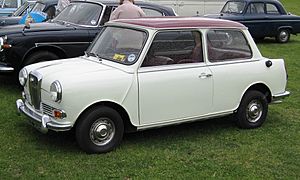
- Four-cylinder models:
- 1939–1948 Wolseley Ten
- 1946–1948 Wolseley Eight
- 1948–1953 Wolseley 4/50
- 1952–1956 Wolseley 4/44
- 1957–1965 Wolseley 1500
- 1958–1961 Wolseley 15/60
- 1961–1969 Wolseley Hornet
- 1965–1974 Wolseley 1100/1300
- 1967–1971 Wolseley 18/85
- Six-cylinder models:
- 1938–1948 Wolseley 14/60
- 1948–1954 Wolseley 6/80
- 1954–1959 Wolseley 6/90
- 1959–1961 Wolseley 6/99
- 1961–1968 Wolseley 6/110
- 1972–1975 Wolseley Six
- March–October 1975 Wolseley saloon (18–22 series)
Aero Engines
Wolseley also made several aircraft engine designs.
- Wolseley 30 hp (4-cylinder) - 1908
- Wolseley 50 hp (V-8 air-cooled) - 1909
- Wolseley 80 hp Type B
- Wolseley 60 hp Type C (V-8)
- Wolseley Aquarius
- Wolseley Aries
- Wolseley Viper
Wolseley Aero Engines Ltd. was a separate company formed around 1931. It designed airplane engines. In 1935, this part of the business became Nuffield Mechanizations Limited.
They were working on an advanced radial aero engine. But the project was stopped in 1936.
See also
- Arthur John McCormack
- Wolseley Racing
- The Wolseley restaurant in London, in the old Wolseley showroom.
- List of car manufacturers of the United Kingdom


